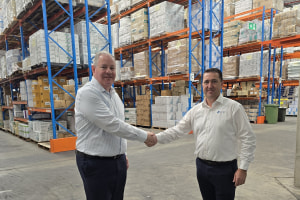Chocolate is worth $1.4 billion in Australia, and single-origin is the fastest growing trend within this industry. However, there are ongoing concerns over global cocoa supply shortages, making efforts to establish new cocoa industries crucial.
Twenty years ago it was thought impossible to grow cocoa here in Australia. It wasn't until the year 2000 that the Queensland government approved the first of a series of trials to be undertaken in the Daintree Rainforest, and in 2002 the first cocoa pods were harvested in Mossman, Queensland.
In 2010, after eight years of research, studies concluded that the foothills of the UNESCO heritage-listed Daintree Rainforest provided the ideal conditions for cocoa to thrive. From there Australian-made chocolate from Australian-grown cocoa was finally born.
To improve efficiencies in the industry, the Queensland government, together with its research and development partners, created a prototype for a mechanical cocoa pod splitter. This machine is estimated to split approximately 5000 cocoa pods per hour. Linked with another machine, which separates the wet beans from the split pods, the whole system, once successful, will greatly reduce labour costs.
A fledgling company, Daintree Estates Cocoa, is involved in the study and further refinement of the technology, and the prototype is currently undergoing testing and improvement.
Earlier this year the company achieved an impressive milestone in the local chocolate industry when it finished construction on its dedicated post-harvest pod processing facility in Mossman.
Post-harvest processing is an integral part of creating the best flavour precursors in chocolate. The facility handles pod splitting and bean extraction, fermentation, drying, roasting, cracking and winnowing.
Daintree Estates also has a small-scale chocolate-making operation where recipe development, conching, tempering and moulding operations are tested. New machines for the cocoa industry are also tested for improvement and refinement. The facility provides an integral step in creating and crafting Australian chocolate and developing and improving current cocoa processing practices.
Laying the groundwork
The facility is largely based on traditional cocoa processing methods practised and refined through trial and error around the world. From there, Daintree Estates has selected and adapted procedures that are best suited for the Australian environment. While some processes are mechanised, others, such as the fermentation process, rely greatly on natural chemical reactions imparting distinct flavour precursors on the cocoa.
The cocoa pods take approximately five to six months to ripen and mature on the tree. Once ripe, the pods are carefully harvested by the farmers and placed in crates to be delivered to the post-harvest facility.

Perfecting the process
A labour-intensive process follows whereby the pods are split by hand and the beans are removed from the shell. This process is undertaken within two days of harvesting.
Once all the beans have been removed from the pods they are placed inside porous wooden boxes made of quila. Wood has good insulating properties and can hold the natural yeast necessary to trigger the process of fermentation.
Fermentation triggers chemical reactions, which create flavour precursors in the cocoa, eventually transforming into beautiful chocolate aromas. If this is not managed carefully, the chocolate will not have a good flavour profile despite the quality of the cocoa beans used. During this process, the cocoa beans get an identity. The perception of citrus tones correlate to acidity level, and flavours of berries and floral notes come from alcohols produced by yeasts during fermentation. These flavour notes affect the final product.
Due to seasonal temperature changes, the challenge is controlling the rate of fermentation to achieve consistent results. Daintree Estates is studying different processes to maintain consistency in the fermentation process. Experiments on procedures that allow them to control certain factors are performed at the post-harvest facility where they explore techniques and processes that are practised in cheese and wine making that may have parallel results.
The drying stage
The next step is the drying of the cocoa beans. The beans are dried in a natural process where fermented beans are laid on steel trays placed in a purpose-built shelter and gently dried under the sun, allowing the remaining acids in the seeds to evaporate and produce a low-acid, high-cocoa flavoured product. The whole process is dependent on ambient temperature and humidity levels, which can take up to 10 days. The rate of drying has an important effect on the flavour and quality of the dried beans: too slow and mould may develop, too fast and oxidative reactions are not completed thoroughly. Correctly drying the beans reduces moisture content and makes the beans resistant to spoilage. In high humidity regions, artificial drying methods are used. These methods, incorrectly performed, can create harsh, smoky aromas that contaminate the taste of the cocoa beans and inhibit the evaporation of acetic acid, resulting in beans with a sour flavour profile.

Ready for roasting
At this point, the post-harvest process is finished. However, the next steps in cocoa processing are also performed in the facility. This first involves roasting. This delicate process builds on the flavour precursors created during fermentation and drying. The cocoa beans are roasted using a 20kg drum roaster. Various flavours are awakened due to the effect of the Maillard reaction where hundreds of different flavour compounds are created, which in turn break down to form yet more new flavour compounds, resulting in flavour precursors being converted into rich caramel and nutty flavour notes.
The roasted beans then go through a process of winnowing where the shells are separated from the beans. The beans are cracked separating the nibs from the husks. With movement and the right amount of airflow, the lighter weight husks are separated from the nibs. The nibs are then ground into cocoa mass along with other ingredients to produce chocolate where it will go through a process of conching.
Creating a paste
Conching is the process of grinding the cocoa mass into very fine smooth paste. The facility in Mossman has a small-scale production set-up where conching is carried out using a nib pregrinding cycle, followed by a stone ground melanger cycle. Recipe development and testing are also performed on-site. Larger production quantities are sent to Daintree Estates' contracted processing chocolate refiners. Both types of conching produce a final chocolate that has a particle size less than 18 microns, which the human tongue can no longer recognise as gritty. Prolonged conching time gentrifies the flavours in the chocolate. This is the final stage of flavour development. The fluid chocolate is then pre-crystallised and moulded into chocolate blocks or bars.

Elaine Young is a consulting pastry chef and chocolatier who provides expert advice and creative input for pastry and chocolate operations to the hospitality and food manufacturing industries. She can be contacted at elaine@ediblejourneys.com.au.









